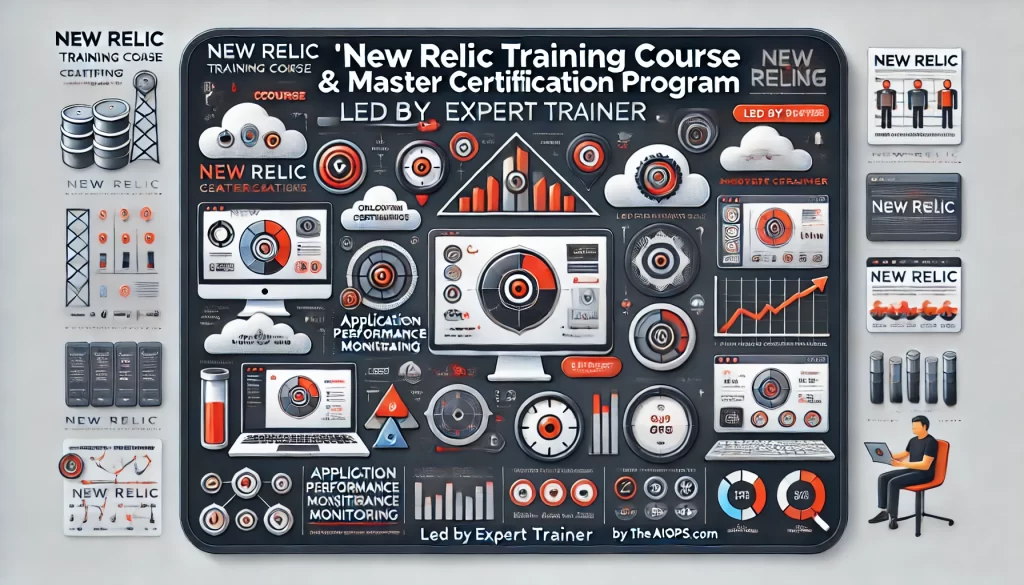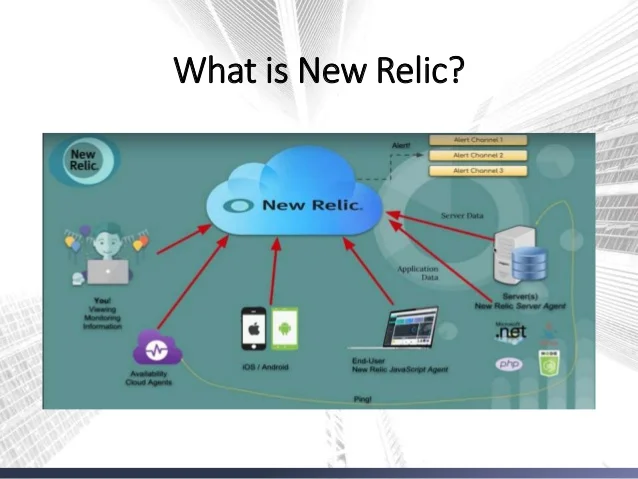
The New Relic Training Course & Master Certification Program by theaiops.com is an in-depth training program designed to equip IT professionals, DevOps engineers, and application developers with the expertise needed to master New Relic, a leading observability platform. Led by expert trainer Rajesh Kumar from RajeshKumar.xyz, this course covers key New Relic features such as application performance monitoring (APM), infrastructure monitoring, distributed tracing, and real-time alerting. Participants gain hands-on experience in setting up and managing New Relic to monitor application health, optimize performance, and troubleshoot complex issues across distributed environments. Through practical exercises and real-world scenarios, learners become proficient in using New Relic’s dashboards, alerts, and analytics for comprehensive visibility and actionable insights. The course prepares participants for the New Relic Master Certification, validating their skills and positioning them as knowledgeable professionals in the field of observability. By completing this training, professionals are empowered to enhance application reliability, drive efficiency, and support proactive performance management in their organizations.
What is New Relic?

New Relic is a comprehensive observability platform designed to monitor, troubleshoot, and optimize the performance of applications, infrastructure, and digital experiences. Widely used by IT and DevOps teams, New Relic provides real-time visibility into the health of applications, servers, databases, and cloud environments, enabling teams to detect and resolve issues before they impact users. With features like Application Performance Monitoring (APM), infrastructure monitoring, distributed tracing, and synthetic monitoring, New Relic allows organizations to pinpoint performance bottlenecks, monitor dependencies, and gain insights into user interactions. Its intuitive dashboards, alerting system, and AI-powered analytics facilitate data-driven decision-making, helping businesses maintain reliable, high-performing digital systems. By centralizing observability data in one platform, New Relic empowers organizations to enhance their digital operations, improve customer experiences, and achieve operational excellence across complex, distributed environments.
Why New Relic is Important
With the increasing complexity of cloud-native and distributed systems, New Relic has become an indispensable tool for organizations striving to deliver high-performance, reliable applications. Here’s why mastering New Relic is essential for modern IT and DevOps teams:
- End-to-End Visibility: New Relic offers a unified view across applications, infrastructure, and user experiences, enabling teams to see how all components work together and how each one impacts the overall performance.
- Proactive Performance Monitoring: By setting up alerts and performance thresholds, teams can proactively detect issues before they impact users, ensuring uptime and reliability.
- Enhanced User Experience: With tools like RUM and synthetic monitoring, New Relic enables teams to focus on user experience, helping identify areas where users may experience delays or issues.
- Support for Complex Architectures: As more organizations adopt microservices, containerization, and multi-cloud environments, New Relic’s distributed tracing and infrastructure monitoring are vital for maintaining visibility and control.
- Scalability and Adaptability: New Relic can scale with infrastructure, supporting small businesses to large enterprises alike. Its adaptable architecture allows teams to monitor both legacy and cloud-native systems in a single platform.
- Data-Driven Decisions and Optimization: By turning raw data into actionable insights, New Relic empowers teams to make informed decisions, optimize resource usage, and improve business outcomes.
Learning to use New Relic effectively enables IT teams to maintain high-performance standards, ensure security, and deliver exceptional user experiences, making it a critical skill for any modern technology professional.
Course Features
This New Relic training course offers an in-depth, hands-on learning experience, equipping participants with the skills to leverage New Relic’s capabilities in real-world environments. Key features include:
- Comprehensive Curriculum: Covers New Relic’s core tools, from APM to RUM and synthetic monitoring, offering a full understanding of each feature’s role in monitoring and observability.
- Hands-On Labs and Practical Exercises: Each module includes guided labs where participants will configure monitoring tools, build dashboards, and set up alerts, applying their skills in real-time.
- Industry-Specific Case Studies: Participants will work through real-world scenarios and industry-specific use cases, including troubleshooting performance, monitoring cloud services, and improving user experience.
- Lifetime Access to Course Materials: Participants have lifetime access to recorded sessions, guides, and resources, allowing them to revisit and continue learning at their own pace.
- Led by an Industry Expert: The course is led by Rajesh Kumar, a seasoned New Relic expert, who brings years of experience and practical insights to the course, helping participants apply what they learn effectively.
Training Objectives
By the end of this course, participants will have mastered New Relic’s functionalities and will be equipped to deploy comprehensive monitoring solutions. Key objectives include:
- Configuring New Relic for Full-Stack Monitoring: Set up New Relic for application, infrastructure, and user monitoring, creating a holistic view of system health.
- Tracking Application Performance with APM: Use APM to monitor key application metrics, troubleshoot issues, and optimize performance.
- Creating and Customizing Dashboards and Alerts: Develop custom dashboards that track performance metrics and configure alerts for proactive monitoring and quick response.
- Using Distributed Tracing for Microservices: Leverage distributed tracing to understand dependencies, identify bottlenecks, and troubleshoot issues across microservices.
- Implementing Real User Monitoring (RUM): Track real user interactions to understand user behavior and enhance application performance for end-users.
- Configuring Synthetic Monitoring for Proactive Testing: Set up synthetic monitoring to simulate user workflows and test application availability.
- Analyzing Logs and Metrics for Faster Troubleshooting: Use New Relic’s log and metric management tools to improve root-cause analysis and minimize downtime.
Target Audience
This course is designed for professionals in a variety of IT and development roles:
- System Administrators and IT Operations Teams: Responsible for infrastructure health, uptime, and reliability.
- Application Developers and Performance Engineers: Developers focused on optimizing application performance and debugging issues.
- DevOps Engineers: Engineers working on CI/CD pipelines and deployment automation who want to integrate monitoring with DevOps workflows.
- Cloud Engineers and Architects: Professionals managing cloud-based environments who need visibility into multi-cloud and hybrid infrastructures.
- Security Analysts: Professionals aiming to enhance security monitoring and incident response through New Relic’s monitoring capabilities.
- Product Managers and UX Teams: Teams interested in improving the user experience by understanding real user interactions and identifying performance bottlenecks.
Training Methodology
This course is designed to be engaging and immersive, with a blend of lectures, hands-on labs, and interactive exercises that provide participants with both theoretical understanding and practical skills:
- Lecture-Based Sessions: Each module begins with a detailed lecture covering core concepts, the functionality of New Relic tools, and real-world applications.
- Hands-On Labs for Real-World Practice: Labs are structured to reinforce learning, providing direct experience with New Relic tools such as APM, RUM, and synthetics, enabling participants to apply skills as they learn.
- Project-Based Assignments and Case Studies: Participants will work through realistic assignments and industry-relevant case studies, applying their skills to troubleshoot, optimize, and secure application environments.
- Interactive Q&A and Discussions: Opportunities for Q&A and discussion foster collaborative learning and allow participants to clarify concepts.
- Assessments and Feedback: Regular quizzes and assignments gauge comprehension and reinforce skill mastery, ensuring participants are ready to apply their knowledge professionally.
Certification Program
Upon course completion, participants will receive a certification from DevOpsSchool.com, validating their expertise in New Relic’s monitoring and observability tools. This certification is recognized across industries and serves as a testament to participants’ skills.
- Industry-Recognized Certification: Certification confirms participants’ proficiency in New Relic setup, monitoring, troubleshooting, and optimization, enhancing their professional credentials.
- Digital Badge for Profiles: Participants receive a digital badge that can be displayed on LinkedIn profiles, resumes, and other professional platforms.
- Lifetime Access to Certification Resources: Certified participants have access to course resources for continuous learning and skill development.
Agenda of New Relic Training Program
Day 1: Introduction to New Relic and Application Monitoring
- Overview of New Relic’s Platform and Architecture: Introduction to New Relic’s core features, components, and architecture.
- Setting Up New Relic APM: Installing APM agents, configuring key metrics, and monitoring application performance.
- Introduction to Query Language (NRQL): Using NRQL to query data, filter information, and create custom queries for specific insights.
- Hands-On Lab: Setting up APM, running NRQL queries, and creating dashboards to visualize application performance metrics.
Day 2: Infrastructure Monitoring, Dashboards, and Alerts
- Configuring Infrastructure Monitoring: Setting up infrastructure monitoring for cloud resources, containers, and on-premises servers.
- Creating Custom Dashboards: Building dashboards to track key performance metrics, monitor trends, and support capacity planning.
- Alerting and Incident Management: Configuring alerts and notifications for proactive incident response and performance tracking.
- Hands-On Lab: Setting up infrastructure monitoring, creating custom dashboards, and configuring alerts based on performance thresholds.
Day 3: Real User Monitoring, Synthetic Monitoring, and Security
- Real User Monitoring (RUM): Capturing user behavior and session data to gain insights into the user experience and improve application performance.
- Synthetic Monitoring: Setting up synthetic monitoring to simulate user journeys, test availability, and measure application response times.
- Security Monitoring and Compliance: Configuring security alerts, monitoring for vulnerabilities, and maintaining compliance within New Relic.
- Hands-On Lab: Configuring RUM and synthetic monitoring, setting up security alerts, and creating dashboards to track user interactions and security events.
Lab Setup
To ensure hands-on learning, participants will set up a structured lab environment that includes:
- Required Software: New Relic agents, sample applications (provided), and access to cloud or local servers for monitoring.
- Hardware Requirements: A laptop or desktop with at least 8GB RAM, multi-core processor, and stable internet connectivity.
- Cloud or Local Setup Options: Labs can be set up on cloud platforms such as AWS, Azure, or GCP, or configured locally according to participant preference.
- Step-by-Step Setup Guide: Detailed setup instructions are provided, ensuring participants are prepared for labs and hands-on exercises.
Trainers
The course is led by Rajesh Kumar, an expert in observability, performance engineering, and cloud infrastructure monitoring. Rajesh brings years of experience implementing New Relic solutions across diverse industries and delivers training focused on real-world applications, ensuring participants gain valuable and immediately applicable skills.
Frequently Asked Questions (FAQ)
- Who should attend this New Relic course?
- Ideal for system administrators, application developers, DevOps engineers, cloud architects, security analysts, and product managers.
- Do I need prior New Relic experience?
- No prior experience is required, though a basic understanding of IT infrastructure and data analytics is beneficial.
- Will I receive hands-on training?
- Yes, each module includes hands-on labs to gain practical experience with New Relic’s tools.
- How does New Relic compare to other monitoring tools?
- New Relic provides end-to-end observability across applications, infrastructure, and user experiences, with unique features like NRQL for custom queries.
- Is this course beginner-friendly?
- Yes, the course covers both foundational and advanced topics, making it suitable for beginners and experienced professionals.
- Can New Relic monitor multi-cloud environments?
- Yes, New Relic integrates with major cloud providers, including AWS, Azure, and GCP.
- Will I receive certification?
- Yes, a certification from DevOpsSchool.com is awarded upon course completion.
- Do I have lifetime access to the course materials?
- Yes, participants receive lifetime access to all course materials and resources.
- Can New Relic help with compliance?
- Yes, New Relic provides security monitoring that aids in compliance with standards such as GDPR, HIPAA, and PCI-DSS.
- How is RUM different from synthetic monitoring?
- RUM tracks actual user sessions, while synthetic monitoring simulates user interactions to test availability and performance.
- Is this course suitable for security professionals?
- Yes, New Relic’s security monitoring features are covered, making it valuable for security teams.
- Can New Relic be used with DevOps practices?
- Absolutely. New Relic integrates with CI/CD pipelines and supports performance monitoring in DevOps workflows.
- What industries use New Relic?
- New Relic is used across finance, e-commerce, healthcare, technology, and other sectors that rely on application reliability and performance.
- Is there post-course support?
- Yes, participants have ongoing access to resources, and support is available for questions.
- Can I integrate New Relic with other tools?
- Yes, New Relic supports integrations with various DevOps, ITSM, and security tools.
